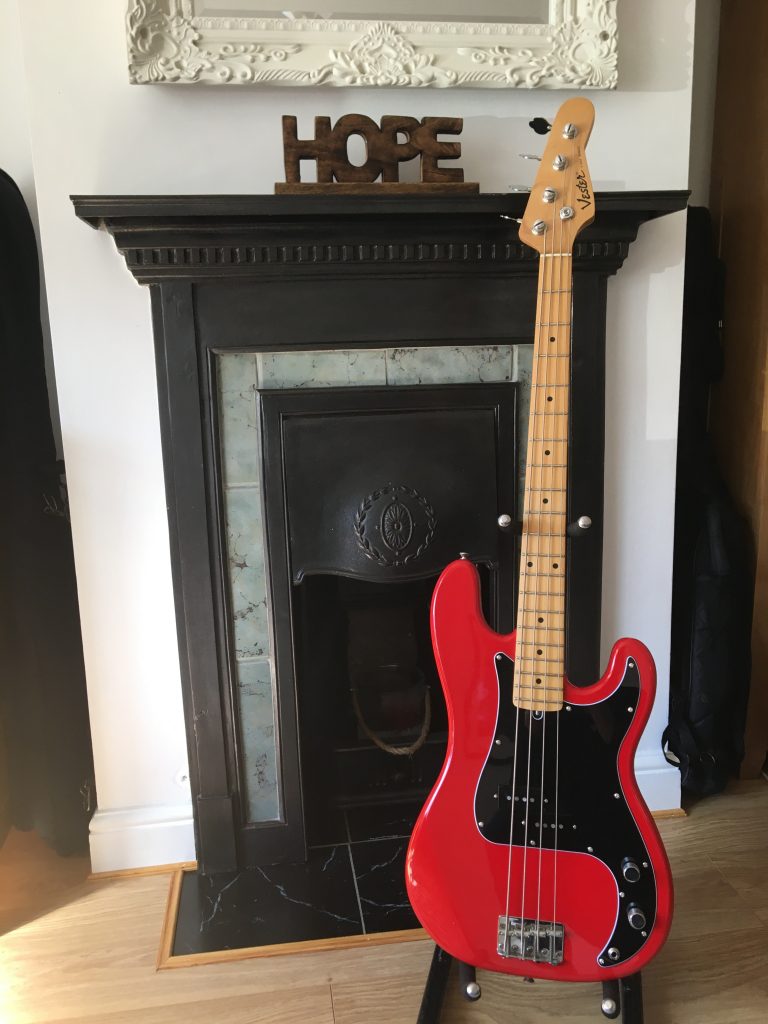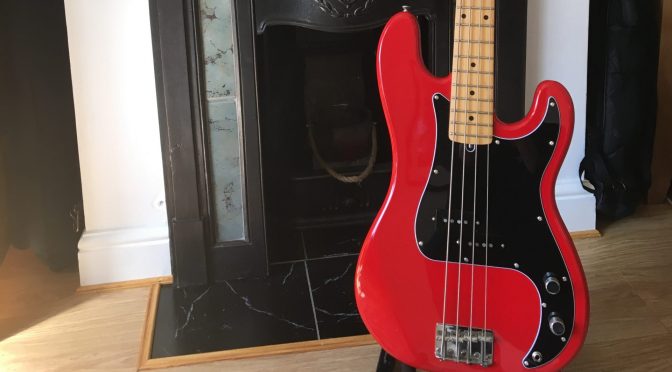Fender Custom 62 Precision Bass Pickup on Vester P Bass Demo – Bass Practice Diary – 28th April 2020
This is a quick demo I recorded this week for my Vester P Bass (Vester Stage Series). The bass sound is completely unedited. I wanted to try and give you the clearest idea of what the bass sounds like now that I’ve installed a Fender Custom 62 Precision bass pickup. The bass was recorded directly from the line out of my Markbass Little Mark III. All the EQ on the amp was set flat. I did no editing after recording and I didn’t add any EQ, effects, compression or anything else.
Last week I ripped all of the rusty old electronics out of this 26 year-old bass and I installed a new Fender Custom 62 Precision bass pickup on it. This week I’ve been playing this bass, the first bass I ever owned, for the first time in about 20 years. It’s bought back all kinds of memories of my childhood. And I’ve found myself remembering things that I used to try and play in those early days of learning to play the bass. That’s why I’ve recorded a shuffle blues here, because my abiding memory of this bass is playing shuffle 12-bar blues when I was 11, 12 & 13 years of age.
My First Childhood Bass
It’s funny, this was the first bass I ever owned, but it’s entirely different to any of the other basses that I’ve owned since. I’ve never owned a Fender Precision (or Squier) and I currently don’t own another bass that has a P style pickup on it. It’s also the only bass that I’ve ever owned that has a maple fretboard.
It’s easy to look back at your first instrument with a kind of misty eyed nostalgia, but the truth is, for me, this bass unconsciously became a kind of blueprint for how I didn’t want my future basses to be. Thinking back to my first ever bass teacher, he played a proper Fender USA made Jazz Bass. My Vester suffered in comparison, and I’m sure that unconsciously coloured my opinions of J and P style basses ever after. Later in my teens, as I started to hear modern style active basses like Warwicks. They became my blueprint for what I thought a great bass tone should be, and I moved further away from P style basses.
I remember that the electronics stopped working when I was in my late teens. I did try to get them working again, with some initial success. By that point, I already owned a newer 5-string bass. And when the electronics stopped working a second time, I didn’t have the money or the expertise to fix it. So, for about 20 years, the Vester Stage Series P Bass sat unused in a flight case in the loft. Only coming out when I moved house, or I needed the flight case to take a different bass on tour.
Vester Stage Series P Bass
What I didn’t appreciate as a child, is that there’s actually some really good things about this bass. The best thing about this bass, by far, is the neck. It’s a really good playable maple neck. I entirely failed to appreciate this as a child because I didn’t have enough experience of playing bass necks. The original bridge on the Vester is also an excellent copy of vintage style Fender P Bass Bridge. It’s still on the bass and in perfect working order, as are the Fender style tuners. It was such a good copy of a Fender P bass that Fender successfully sued them. The basses were no longer manufactured after that.
The biggest problem with the bass originally was that it wasn’t very inspiring to listen to. If only I’d known in the 90’s how easy it is to change the pickup on a P style bass.
Installing a Fender Custom 62 Precision Bass Pickup
Installing the Fender Custom 62 pickup couldn’t have been easier. It was actually much harder to get the old pickup out than it was to put the new pickup in. The screws holding the old pickup in place were so rusty that the screw heads had virtually disintegrated. Meaning that unscrewing them was impossible. I had to break the old pickups to remove them, and then remove the old screws with pliers.
Putting in the new pickup was as simple as, finding the position of the pickups using the old scratchplate, making new holes for the four screws and then soldering two wires. The Fender Custom 62 Pickup comes with a white wire and a black wire. And a diagram showing you where to solder them.
Apart from installing the pickup, the other work I did included changing all of the wiring, pots and input, cleaning and polishing the frets and the fretboard and installing a new scratchplate with access to the truss-rod. The video was shot just before the new scratchplate arrived, so here’s a picture of the finished bass.

The Guitar Solo
The guitar solo in the video is part of a transcription I’ve been working on this week from Frank Gambale. Here is a PDF of the transcription with guitar TAB.

